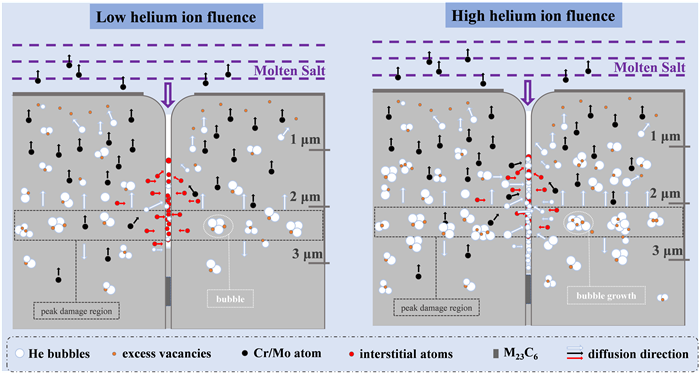






Research progress on the synergistic effect of irradiation and molten salt corrosion of nickel-based alloy
Recently, the irradiation effects research group in Shanghai Institute of Applied Physics has made important progress in the research of the synergistic effect of irradiation and molten salt corrosion of nickel-based alloy. This work elaborates the synergistic effect of irradiation and molten salt corrosion under different irradiation conditions and reveals the related mechanism. The related results are published recently in Corrosion Science 185 (2021) 109434 with the title of "synergy effect of radiation and molten salt decoration: acceleration or cancellation?". The first author is Ph.D Student Zhenbo Zhu and the corresponding author is Professor Hefei Huang.
As the most promising candidate structural material for MSRs, nickel-based alloy is subjected to extreme service environments, such as high temperature, high neutron irradiation and strong fluoride molten salt corrosion. However, the synergistic effect of irradiation and corrosion is controversial. Previous studies show that the defects, such as helium bubbles, introduced by irradiation not only provide a channel for the rapid diffusion of molten salt, but also increase the contact area between molten salt and alloy, thus accelerating the corrosion of molten salt. However, recently researchers have found that the interstitials introduced by irradiation fill the vacancy due to the loss of Cr in the GBs. This self-healing mechanism can decelerate the corrosion of molten salt. In order to reveal the effect of irradiation on corrosion in detail, the corrosion tests were performed at 700 °C on the nickel-based alloy GH3535 alloy and Inconel 617 alloy, after irradiated by He+ ion with the low and high ion fluence at high temperature.
The results showed that irradiation accelerated matrix corrosion for both alloys. The irradiated Inconel 617 alloy underwent corrosion attack along the GBs in the case of high ion fluence was more serious, whereas in the case of low ion fluence it showed a certain degree of slowdown. In this work, the author revealed the causes of the above differences and proposed the inhibited and accelerated corrosion mechanism of irradiation under different irradiation conditions: For matrix corrosion, the helium bubbles were responsible for accelerating corrosion, and its influence increased with the increase in irradiation fluence. As for intergranular corrosion, the positive effects including the blocking effect of interstitial and the self-healing accelerated by irradiation, and the negative effect caused by helium bubbles along the GBs competed during corrosion. In the case of low ion fluence, a large number of interstitial atoms were absorbed by GBs, further blocking the corroded channels along the GBs. Thus, the positive effects dominated and led to the deceleration of intergranular corrosion. In the case of high ion fluence, though more interstitial atoms were absorbed by GBs, helium bubbles aggregated in the GBs played the dominant role in accelerating intergranular corrosion. This finding provides an important basis for reasonable evaluation of the service performance of high temperature nickel-based alloys in MSRs.
The research was supported by the National Natural Science Foundation of China and the Youth Innovation Promotion Association, CAS.
Link: https://www.sciencedirect.com/science/article/pii/S0010938X21002006

Fig.1. Influence of irradiation on the matrix and intergranular corrosion in Inconel 617 irradiated by helium ions with the low and high ion fluences.